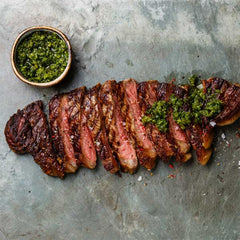
Pesto, chimichurri, pico de gallo, sage butter, béarnaise sauce…if you love cooking, you know everything tastes better with fresh herbs. Even basic scrambled eggs are elevated with a sprinkle of chives right from your window box.
Not only do fresh herbs taste better, but they are also relatively easy to grow and in many cases cheaper than store-bought. Forget about wondering if the cilantro you bought last week has turned into a soggy mess in the bottom of your refrigerator – grow your own herbs instead! You might be surprised how easy it is to be a plant parent to a thriving culinary garden right in your own home.
Location and Selection
The first thing you want to do is decide where you want to grow your herbs. Most herbs are happiest with full sunlight but as long as you can get a few hours of the day then there are options for your garden space.
Some herbs that do well in shade include:
- Cilantro - which prefers the cooler temperatures of early spring and late fall
- Tarragon - great for poultry, fish, and salads
- Chives – one of the easiest herbs to grow (even from seeds) and taste great on everything
- Mint – an aggressive plant best grown in a pot. Mint has a tendency to creep out of the drainage hole to spread if it has a chance, so be aware
- Parsley – another easy to grow herb that does well in shade or sun
When it comes to sun-loving herbs, you’ll find many of your favorites:

- Basil – best known for Italian and Thai cuisine, the flavor ranges from sweet with a hint of licorice, to spicy and clove-like, depending on the varietal
- Dill – perfect for breakfast, salads, Mediterranean food, and of course, pickles
- Lavender – not just a pretty flower; lavender is great in teas, salads, and desserts. Bonus: it’s great for attracting pollinators
- Oregano – another Italian favorite. Oregano is great with meat and is also a key ingredient in Argentinian chimichurri
- Rosemary – can be kept small in an herb garden or grown into a potted topiary. Try it on potatoes and chicken
- Sage – poultry spice wouldn’t be the same without sage. It’s also a great addition to marinades and compound butter
- Thyme – boasts a floral, peppery flavor to complement onion soup, mushrooms, and most roasts
Getting started
While you can certainly grow most herbs from seeds, the easiest way to get started is to visit your local garden center and pick up some plants. In many cases, live plants will be nearly the same price as buying fresh herbs at the market and will provide a better yield in the long run.
You will need to replant your herbs after you bring them home. Herbs are perfect for container gardening, as they don’t take up much space. Choose containers with good drainage, as most herbs will rot if they are left sitting in water. Then plant with high-quality potting soil, and add in a little cactus mix to help to control moisture.
For best results, check the recommendations on the plant for optimal spacing and any other specifics of your planting zone. Also, consider opportunities for companion planting. Herbs like basil, parsley, and garlic can repel bugs, improve growth, and even improve flavor when planted with tomatoes.
Caring for your herb garden
Regular watering is the main requirement to keep your herb garden happy. While watering needs depend on the type of herb, it’s good practice to be consistent and to keep watch for wilting plants, dry soil, or overwatered soil. Yellowing plants are a sign that your herbs need more nutrients. If you see that, you may consider applying a liquid fertilizer once or twice a month to give new life to your herbs and enhance their yield.
Using up your bounty
This is the fun part of caring for herbs. Harvest regularly (at least once a month) so the plants don’t flower or go to seed – unless it’s the end of the season and you want to encourage a new cycle for next year’s garden. However, you’re free to harvest much more frequently for all your culinary desires. Pick too much? You can always dry or freeze your herbs for later use.
Whatever you decide to plant, you’ll be sure to have fun cooking with fresh herbs you grew yourself. Enjoy!



